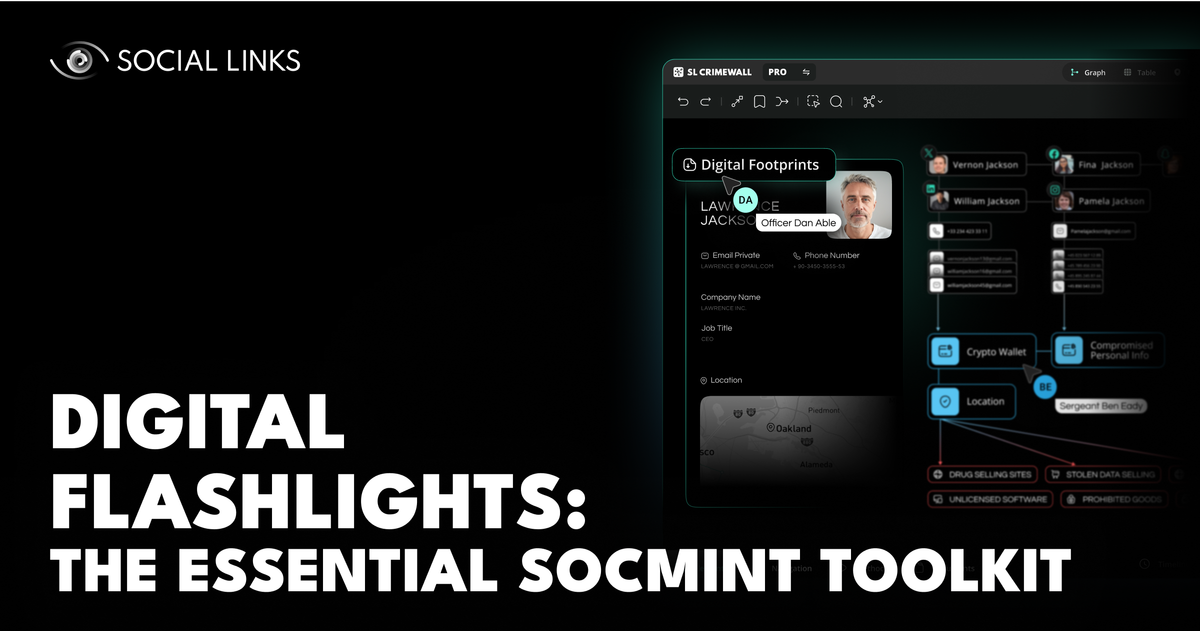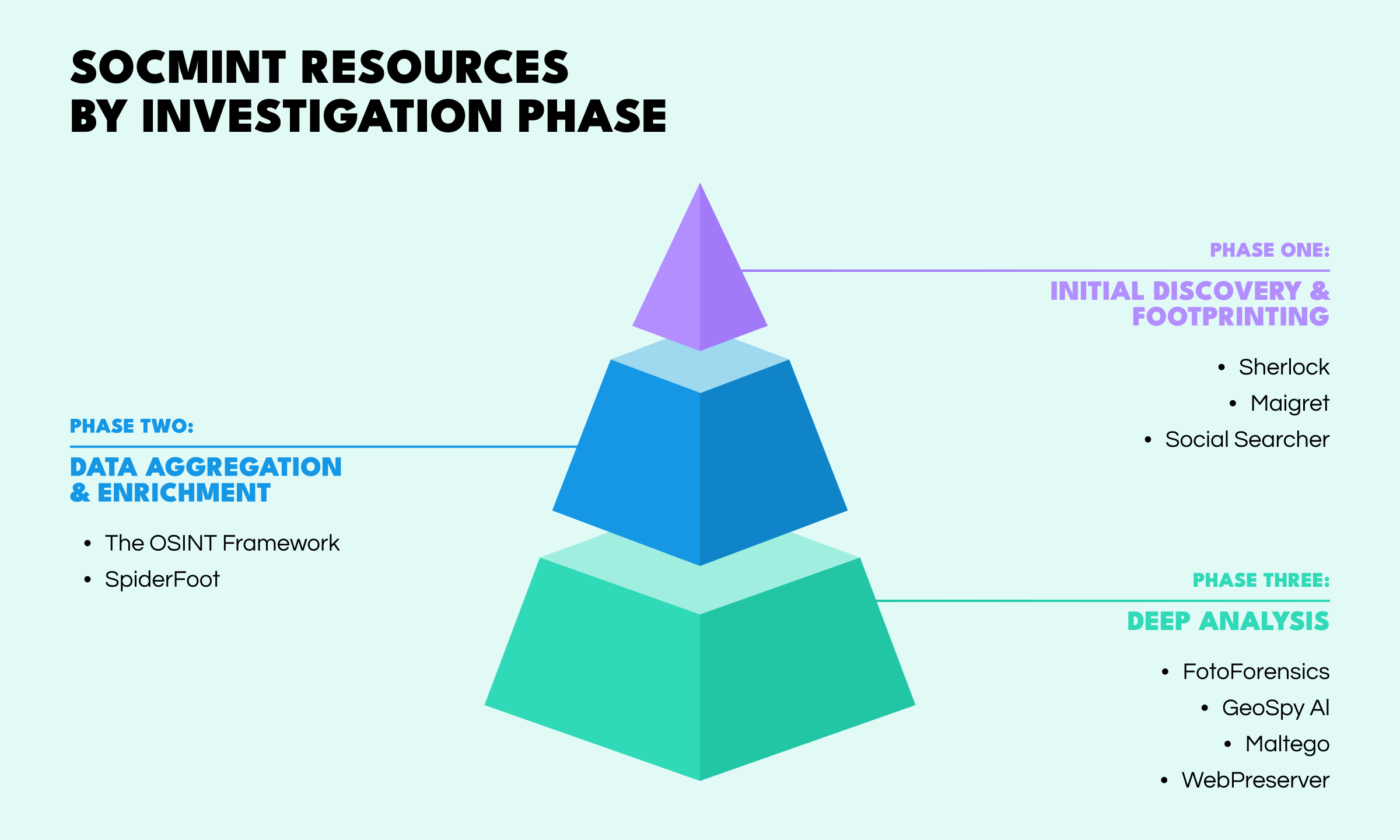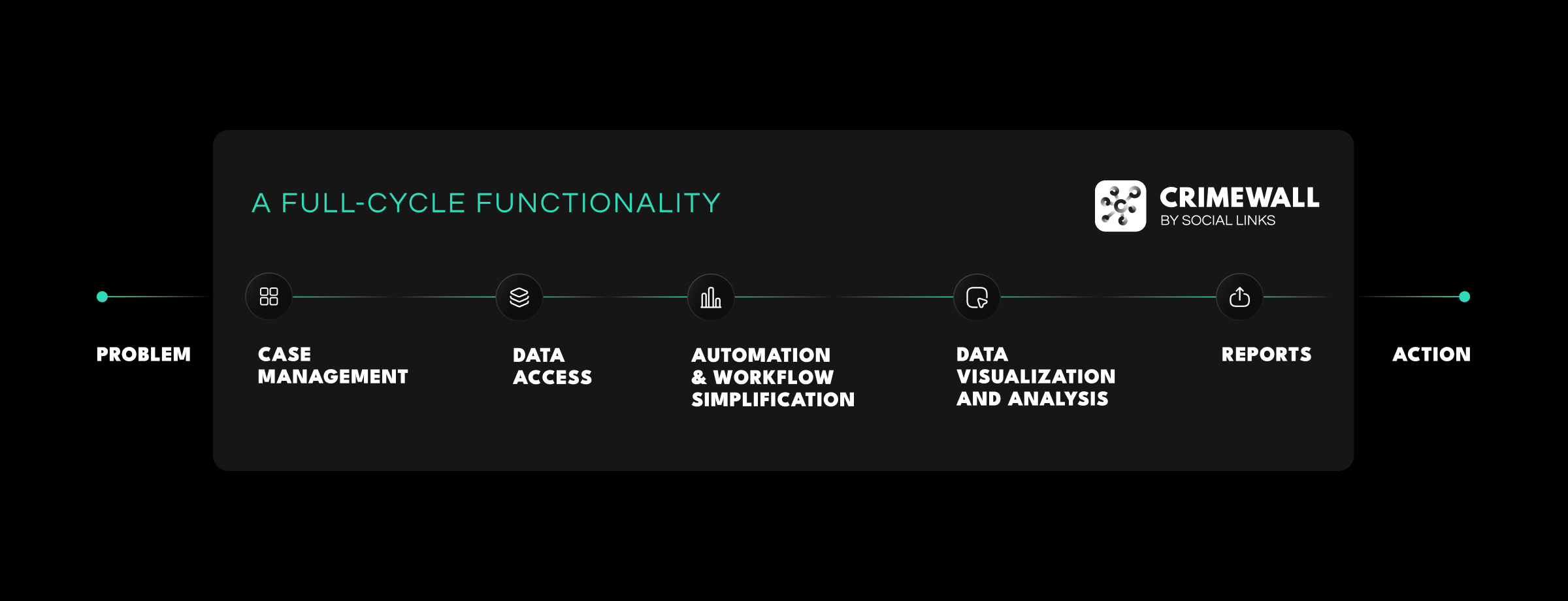Digital Flashlights: The Essential SOCMINT Toolkit


In the sprawling, interconnected digital landscape of the 21st century, social media has grown from a simple communication tool into a detailed, living record of human activity. And this vast store of publicly available information has become an essential resource for a particular field: online investigation.
Social Media Intelligence (SOCMINT)—a key subset of OSINT—centers around systematically collecting and analyzing data from social media to generate actionable insights. For law enforcement, corporate security professionals, and private investigators, mastering these social media investigation tools is no longer optional—it’s essential.
This article gives a complete overview of the tools and techniques that shape modern social media investigations. We’ll cover everything from broad OSINT utilities to highly specialized forensic platforms, focusing on practical applications of advanced systems like SL Professional and SL Crimewall.
Before we look at the social media investigation tools, let’s first consider how investigators map digital activity—they trace connections across multiple platforms and data points to uncover patterns that inform all subsequent steps. This is the digital landscape that shapes the investigative workflow.
Online investigation is about using the internet to gather and analyze information on people, groups, or events. But it goes beyond mere data collection to the identification of patterns and connections that aren’t immediately obvious. This work has a broad application, from tracking cybercriminals and spotting online fraud to carrying out due diligence and background checks.
But at its heart, it’s concerned with mapping out “digital footprints”—data pictures elaborated from the digital traces people leave behind. And this is an area where SOCMINT plays a pivotal—and often revealing—role. By providing a real-time window into a subject's life, associations, and behavior, the discipline can be a real game-changer in legal disputes, criminal probes, and business risk assessment.
A successful social media investigation rarely relies on a single tool. Instead, it involves a dynamic workflow that moves from broad discovery to deep analysis—and the modern investigator's toolkit can be categorized by their utility in a given phase of the process:
The first step is to locate the subject’s online presence. Username enumeration tools like Sherlock or Maigret scan hundreds of platforms for a match. For broader searches, tools like Social Searcher provide real-time monitoring for mentions, users, and trends across multiple networks. These tools help investigators cast a wide net and quickly gather initial public data points.
After finding initial profiles, the next step is building out the network. Resources such as the OSINT Framework allow analysts to put their hand on the online investigation tools they need to tackle a given task. Meanwhile, automated tools like SpiderFoot can take a single piece of information—an email address for instance—and query dozens of public sources automatically to help uncover linked accounts, domains, and other relevant data. Overall, this is a phase that enriches the original data points with context.
With a solid dataset in hand, investigators move into deeper analysis, reaching for tools that reveal hidden details, map relationships, and preserve evidence that holds up under scrutiny.
Image & Geolocation Analysis. Images can be a treasure trove of information. Tools such as FotoForensics can detect manipulation, and metadata viewers can sometimes reveal GPS coordinates. When metadata is missing, AI tools like GeoSpy AI can analyze visual cues—architectural features, foliage, and more—to pinpoint locations with surprising accuracy.
Network & Link Analysis. Understanding relationships is crucial. Maltego—an industry-standard platform for visualizing connections between people, groups, websites, and infrastructure—allows investigators to map out complex networks and identify hidden relationships.
Forensic & Evidence Preservation. When evidence is destined for court, its collection must be defensible. Leading social media forensics tools like WebPreserver capture social media content with verifiable timestamps and metadata, ensuring it stands up to legal scrutiny.

To illustrate how these social media investigation tools work in action, let’s look at three example scenarios, each covering the above phases of discovery, enrichment, and deep analysis.
A company detects a series of credible threats online from an anonymous activist group, and launches an investigation from the group’s username.
Discovery. The team runs Sherlock to locate the username across platforms like X, Reddit, and Telegram. For further identity work and image correlation, investigators increasingly rely on reverse image search, helping validate identities or link social media accounts that use similar visual content.
Enrichment. Using SL Professional through Maltego, the team pulls all public posts, follower lists, and profile details from these accounts, discovering a profile picture, which when reverse-image searched, leads them to a forum for developers.
Deep Analysis. On the forum, they find the user has posted code snippets linked to a GitHub account. Analysis of the code uncovers unique comments that match other online aliases. This web of connections—social profiles, forum posts, and code repositories—is thereby mapped in Maltego, revealing the key actors in the group and their potential real-world identities.
Following a public disturbance, law enforcement has a blurry video of a key instigator.
Discovery. The video is enhanced, revealing a partial view of a unique tattoo. A public appeal brings in social media photos of people at the event.
Enrichment & Analysis. The photos are analyzed using facial recognition tools. One potential match emerges. Investigators then use a comprehensive platform like Crimewall to build a detailed case file on this individual. They pull all the subject’s public social media data from Facebook, Instagram, and other networks, creating a fuller picture of their online presence.
Geolocation & Connection Mapping. An Instagram photo, posted an hour before the disturbance, is geotagged two blocks from the event. Crimewall's link analysis feature is deployed to visualize the subject's network, revealing frequent interactions with other known agitators, establishing a pattern of association and placing the suspect at the scene.
A firm considers a multi-million-dollar investment in a startup. They hire a private investigator to vet the founder.
Discovery. The investigator searches people-databases like Pipl and IRBSearch (two essential private investigator online tools) to collect baseline information, including known email addresses and past residences.
Enrichment. These data points are fed into SL Pro, which quickly uncovers the founder's social media presence, including a seemingly dormant blog and an active Reddit account under a pseudonym.
Deep Analysis. While the LinkedIn profile appears spotless, Reddit comments reveal a history of exaggerating technical achievements, and interactions with individuals linked to failed or controversial projects. These findings give the investment firm critical risk intelligence that traditional background checks would have missed.
While task-dedicated social media investigation tools are powerful, the future lies in platforms that manage the full intelligence cycle, allowing analysts to stop wrangling multiple point solutions and focus on critical thinking. Social Links’ SL Professional and Crimewall solutions combine collection, analysis, and visualization into a single, unified workflow, empowering teams to progress from raw data to actionable intelligence faster, with fewer missed connections.
SL Professional acts as a force multiplier for analysis platforms like Maltego, sparing analysts the drudgery of manually querying dozens of sources. Instead, an investigator can run an “SL Pro Transform” on a single entity, such as a phone number, and automatically populate their graph with linked social media accounts, messenger profiles, Dark Web mentions, and even cryptocurrency wallet activity. This automates the most time-consuming phase of data collection, letting analysts focus on discovering insights rather than just gathering data.
SL Crimewall is a standalone, all-in-one OSINT investigation platform designed to streamline the entire workflow, from data extraction to generating a final report. It integrates data from over 500 open sources and provides a collaborative workspace where a team can manage a case, share evidence, and build hypotheses on a shared project board.
With its ML-powered features (e.g. sentiment analysis and facial recognition) and potent suite of visualization tools (graphs, maps, and tables) SL Crimewall makes complex data understandable and workable for investigators of all skill levels. For a law enforcement agency or corporate security team, Crimewall serves as the central nervous system for all OSINT operations.

Social media investigation is a dynamic and complex ecosystem of tools, encompassing everything from simple search engines to AI-driven geolocation services—each of which have their place in online investigation. But as digital information grows, the real advantage isn’t just in accessing data, but in combining, analyzing, and acting on it quickly and accurately.
While skilled and experienced analysts may be attached to their diversely assembled toolkits, integrated solutions like SL Professional and SL Crimewall signify a significant evolutionary step, helping teams better manage data overload and fragmented workflows. For organizations treating online investigation as a core skill, online investigation tools aren’t just nice-to-haves—they’re the new professional standard for turning the digital shadow into actionable intelligence.
What are social media investigation tools?
Social media investigation tools are platforms and applications that help investigators collect, analyze, and preserve data from social networks. They are used in law enforcement, corporate security, and private investigations to uncover digital evidence and online activity.
What is online investigation?
Online investigation is the process of gathering and analyzing publicly available information from the internet. It often involves the use of online investigation tools to trace digital footprints, identify individuals, and assess risks.
What are the best online investigation tools?
Some of the most effective online investigation tools include SpiderFoot, Maltego, and Social Searcher. These platforms automate data collection and help investigators connect different pieces of information into actionable intelligence.
What are private investigator online tools?
Private investigator online tools are specialized services and databases that help PIs conduct background checks, verify identities, and uncover hidden information. Examples include Pipl, IRBSearch, and LexisNexis.
What are social media forensics tools?
Social media forensics tools are designed to preserve digital evidence in a legally defensible way. Tools like WebPreserver and FotoForensics ensure that social media posts, images, and metadata can be used in court or corporate investigations.
How do social media investigation tools help law enforcement?
Law enforcement agencies use social media investigation tools to track suspects, map connections, and preserve online evidence. These tools can reveal hidden associations, confirm geolocation data, and provide proof for legal cases.
If you’d like to learn more about how SL Professional and Crimewall can revolutionize SOCMINT work, follow the link below and we’ll set up a personalized demo session with one of our specialists.